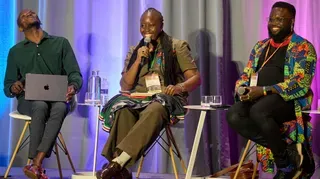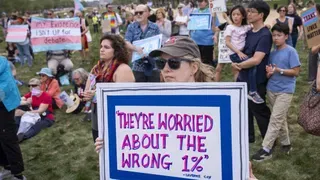February 23, 2014
Three Diets That You Can Try... and Like!
Kilian Melloy READ TIME: 4 MIN.
I'm a big person, so I am trying to find a new food plan (I hate the term diet...it sounds so restrictive and depressing!) that works for me. Hundreds, if not thousands, of you are in the same boat as me. Perhaps you aren't large, but you're still looking to lose a few pounds to right your blood pressure, or to fit into cute bathing suits, or to just feel right in your own skin.
So I did what any responsible person would do. I read up on various plans and I am happy to report that I found a few that sound like they might be good fits for me. I know I am not alone in wanting to pick a new approach to food...one that is healthier, but still tasty, and not boring, and definitely not overly restrictive. Here are three of the plans I found that I think you might like as well!
THE FLEXITARIAN DIET
Dietitian Dawn Jackson introduced The Flexitarian Diet in her 2009 book, "The Flexitarian Diet: The Mostly Vegetarian Way to Lose Weight, Be Healthier, Prevent Disease, and Add Years to Your Life." Now reading up about this plan, I was initially taken aback, because for a grown adult I can be picky with food - I am not a big fan of many vegetables. But I was sold on being allowed meat as a "cheat" if I feel like it! In my experience, I can go about a week into a mostly vegetarian diet before I start craving meat (particularly the grease from meat - how gross is that craving?). With the Flexitarian Diet, I can have it if I choose to, then I go back to the regular plan.
What Do You Eat? The Flexitarian Diet talks about emphasizing five food groups: "New meat" (foods rich in protein such as lentils, beans, tofu, eggs, etc.); whole grains; fruits and vegetables; dairy; and "sugar and spice" (things we add to our dishes to enhance it, like herbs, or honey, or even dressing for a salad).
How Much Do You Eat? You are limited to 1500 calories a day on this diet, but you get three meals a day plus two snacks. You increase your caloric intake slowly throughout the day: 300 calories for breakfast, 400 for lunch, and 500 for dinner. Two 150-calorie snacks round out your day.
Do You Get Results? Yes, and right away. 1500 calories might be restrictive to some people, but couple this with even moderate physical activity and you will notice weight loss. This diet is expected to be followed in cycles of five weeks. After ending the diet, you can always return for another five weeks.
VOLUMETRICS
Nutrition professor Barbara Rolls, who wrote The Ultimate Volumetrics Diet, was the one who spearheaded the thinking behind the Volumetrics eating regime. Rolls says that, in her experience treating patients, everyone tends to eat the same amount of food per day by weight, but that the number of calories, the number of fat grams, etc. can vary widely depending on the food eaten. By putting different foods in categories depending on their "nutrition density," Rolls believes that people can still eat a lot of food if they wish - just different types of foods that impact the body in a more healthy way.
What Do You Eat? Anything you want. I became a fan right away! But of course you have to consume more of the "low-density" foods (examples include fruits and vegetables, grains, low-fat meats and legumes) as opposed to "high-density" ones (my faves like pizza, hamburgers, French fries, and the like). The key is limiting the foods that got us in trouble in the first place and replacing them with ones we should have had all along.
How Much Do You Eat? You can have all three meals a day, a couple of snacks...even a dessert. It all depends on what meals you pick earlier in the day. Make good choices and you can splurge on a properly-proportioned sweet treat at the end of the day. The more good choices you make, the easier it is to notice the results. Speaking of...
Do You Get Results? Yes, you do. Eating more low-density foods means you get fuller off fewer calories, all without overthinking percentages on nutrition labels. The fewer calories you eat makes it that much easier to burn them off when coupled with exercise.
WEIGHT WATCHERS
Everyone's heard of Weight Watchers. In my years trying to lose weight, I had always considered going to a meeting place and paying the meeting fees, but I never followed through. Now that I've stopped to read about what the program entails, it definitely has its upsides. U.S. News and World Report called it the easiest diet to stick to last year, and there's no shortage of help (there are 30 different meeting places for people doing Weight Watchers in Miami-Dade, Broward and Palm Beach Counties, not to mention 25 in the Orlando metro and 20 in Tampa Bay). You get access to all the Weight Watchers points tools, which include charting your progress online or on your phone, on their very own app!
What Do You Eat? Anything you want. This isn't your mother's Weight Watchers anymore; gone are the disgusting recipe cards extolling the virtues of carp and cabbage. The people at Weight Watchers realize we live in a real world and we sometimes eat "cheat foods," and sometimes we go out and have drinks.
How Much Do You Eat? The key is to not go over your allotted food "PointsPlus" limit, which is calculated by your age, height and weight. Foods better for you have a smaller food "Points" allowance, meaning if you save up points, you can splurge if you like. By all means, eat whenever you're hungry, but the key to changing your "food view" with Weight Watchers is to find which foods have fewer points, and to eat a sizable yet moderate amount of those.
Do You Get Results? Yes. "Activity points" are an incentive to get people to exercise each day. The longer one exercises, the more points that can be added to your food/drink allotment that day. Exercise for 30 minutes, for example, and perhaps you worked out two activity points. You can add those to your food points if you wish! Of course you shouldn't do this too much if you want to see continuous results.
Kilian Melloy serves as EDGE Media Network's Associate Arts Editor and Staff Contributor. His professional memberships include the National Lesbian & Gay Journalists Association, the Boston Online Film Critics Association, The Gay and Lesbian Entertainment Critics Association, and the Boston Theater Critics Association's Elliot Norton Awards Committee.







